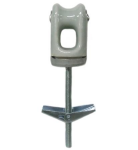grich
Senior Member
- Location
- MP89.5, Mason City Subdivision
- Occupation
- Broadcast Engineer
I hate going to a relative's house and finding problems, but I look for trouble, figuring no one else will notice.
Went to the F-I-L's house today and saw this:

I wonder what will happen first...the neutral connection loosens or the metal fascia cuts through the insulation.
Showed it to the S-I-L...we'll see how fast it gets dealt with.
Went to the F-I-L's house today and saw this:

I wonder what will happen first...the neutral connection loosens or the metal fascia cuts through the insulation.
Showed it to the S-I-L...we'll see how fast it gets dealt with.


